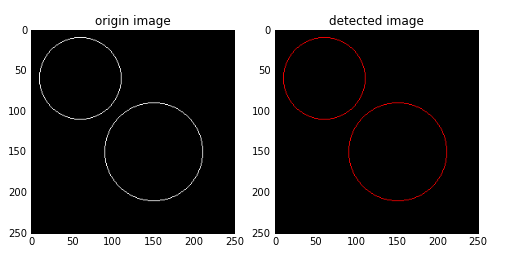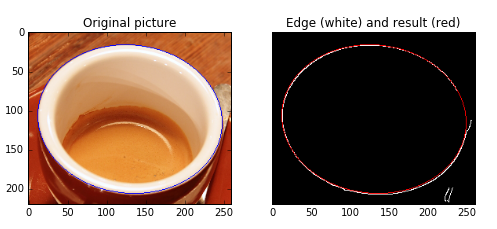Python实现霍夫圆和椭圆变换代码详解
在极坐标中,圆的表示方式为:
x=x0+rcosθ
y=y0+rsinθ
圆心为(x0,y0),r为半径,θ为旋转度数,值范围为0-359
如果给定圆心点和半径,则其它点是否在圆上,我们就能检测出来了。在图像中,我们将每个非0像素点作为圆心点,以一定的半径进行检测,如果有一个点在圆上,我们就对这个圆心累加一次。如果检测到一个圆,那么这个圆心点就累加到最大,成为峰值。因此,在检测结果中,一个峰值点,就对应一个圆心点。
霍夫圆检测的函数:
skimage.transform.hough_circle(image, radius)
radius是一个数组,表示半径的集合,如[3,4,5,6]
返回一个3维的数组(radius index, M, N), 第一维表示半径的索引,后面两维表示图像的尺寸。
例1:绘制两个圆形,用霍夫圆变换将它们检测出来。
import numpy as np
import matplotlib.pyplot as plt
from skimage import draw,transform,feature
img = np.zeros((250, 250,3), dtype=np.uint8)
rr, cc = draw.circle_perimeter(60, 60, 50) #以半径50画一个圆
rr1, cc1 = draw.circle_perimeter(150, 150, 60) #以半径60画一个圆
img[cc, rr,:] =255
img[cc1, rr1,:] =255
fig, (ax0,ax1) = plt.subplots(1,2, figsize=(8, 5))
ax0.imshow(img) #显示原图
ax0.set_title('origin image')
hough_radii = np.arange(50, 80, 5) #半径范围
hough_res =transform.hough_circle(img[:,:,0], hough_radii) #圆变换
centers = [] #保存所有圆心点坐标
accums = [] #累积值
radii = [] #半径
for radius, h in zip(hough_radii, hough_res):
#每一个半径值,取出其中两个圆
num_peaks = 2
peaks =feature.peak_local_max(h, num_peaks=num_peaks) #取出峰值
centers.extend(peaks)
accums.extend(h[peaks[:, 0], peaks[:, 1]])
radii.extend([radius] * num_peaks)
#画出最接近的圆
image =np.copy(img)
for idx in np.argsort(accums)[::-1][:2]:
center_x, center_y = centers[idx]
radius = radii[idx]
cx, cy =draw.circle_perimeter(center_y, center_x, radius)
image[cy, cx] =(255,0,0)
ax1.imshow(image)
ax1.set_title('detected image')
结果图如下:原图中的圆用白色绘制,检测出的圆用红色绘制。

例2,检测出下图中存在的硬币。

import numpy as np
import matplotlib.pyplot as plt
from skimage import data, color,draw,transform,feature,util
image = util.img_as_ubyte(data.coins()[0:95, 70:370]) #裁剪原图片
edges =feature.canny(image, sigma=3, low_threshold=10, high_threshold=50) #检测canny边缘
fig, (ax0,ax1) = plt.subplots(1,2, figsize=(8, 5))
ax0.imshow(edges, cmap=plt.cm.gray) #显示canny边缘
ax0.set_title('original iamge')
hough_radii = np.arange(15, 30, 2) #半径范围
hough_res =transform.hough_circle(edges, hough_radii) #圆变换
centers = [] #保存中心点坐标
accums = [] #累积值
radii = [] #半径
for radius, h in zip(hough_radii, hough_res):
#每一个半径值,取出其中两个圆
num_peaks = 2
peaks =feature.peak_local_max(h, num_peaks=num_peaks) #取出峰值
centers.extend(peaks)
accums.extend(h[peaks[:, 0], peaks[:, 1]])
radii.extend([radius] * num_peaks)
#画出最接近的5个圆
image = color.gray2rgb(image)
for idx in np.argsort(accums)[::-1][:5]:
center_x, center_y = centers[idx]
radius = radii[idx]
cx, cy =draw.circle_perimeter(center_y, center_x, radius)
image[cy, cx] = (255,0,0)
ax1.imshow(image)
ax1.set_title('detected image')

椭圆变换是类似的,使用函数为:
skimage.transform.hough_ellipse(img,accuracy, threshold, min_size, max_size)
输入参数:
img: 待检测图像。
accuracy: 使用在累加器上的短轴二进制尺寸,是一个double型的值,默认为1
thresh: 累加器阈值,默认为4
min_size: 长轴最小长度,默认为4
max_size: 短轴最大长度,默认为None,表示图片最短边的一半。
返回一个 [(accumulator, y0, x0, a, b, orientation)] 数组,accumulator表示累加器,(y0,x0)表示椭圆中心点,(a,b)分别表示长短轴,orientation表示椭圆方向
例:检测出咖啡图片中的椭圆杯口
import matplotlib.pyplot as plt
from skimage import data,draw,color,transform,feature
#加载图片,转换成灰度图并检测边缘
image_rgb = data.coffee()[0:220, 160:420] #裁剪原图像,不然速度非常慢
image_gray = color.rgb2gray(image_rgb)
edges = feature.canny(image_gray, sigma=2.0, low_threshold=0.55, high_threshold=0.8)
#执行椭圆变换
result =transform.hough_ellipse(edges, accuracy=20, threshold=250,min_size=100, max_size=120)
result.sort(order='accumulator') #根据累加器排序
#估计椭圆参数
best = list(result[-1]) #排完序后取最后一个
yc, xc, a, b = [int(round(x)) for x in best[1:5]]
orientation = best[5]
#在原图上画出椭圆
cy, cx =draw.ellipse_perimeter(yc, xc, a, b, orientation)
image_rgb[cy, cx] = (0, 0, 255) #在原图中用蓝色表示检测出的椭圆
#分别用白色表示canny边缘,用红色表示检测出的椭圆,进行对比
edges = color.gray2rgb(edges)
edges[cy, cx] = (250, 0, 0)
fig2, (ax1, ax2) = plt.subplots(ncols=2, nrows=1, figsize=(8, 4))
ax1.set_title('Original picture')
ax1.imshow(image_rgb)
ax2.set_title('Edge (white) and result (red)')
ax2.imshow(edges)
plt.show()

霍夫椭圆变换速度非常慢,应避免图像太大。
总结
以上就是本文关于Python实现霍夫圆和椭圆变换代码详解的全部内容,希望对大家有所帮助。感兴趣的朋友可以继续参阅本站其他相关专题,如有不足之处,欢迎留言指出。感谢朋友们对本站的支持!
您可能感兴趣的文章:Python数字图像处理之霍夫线变换实现详解